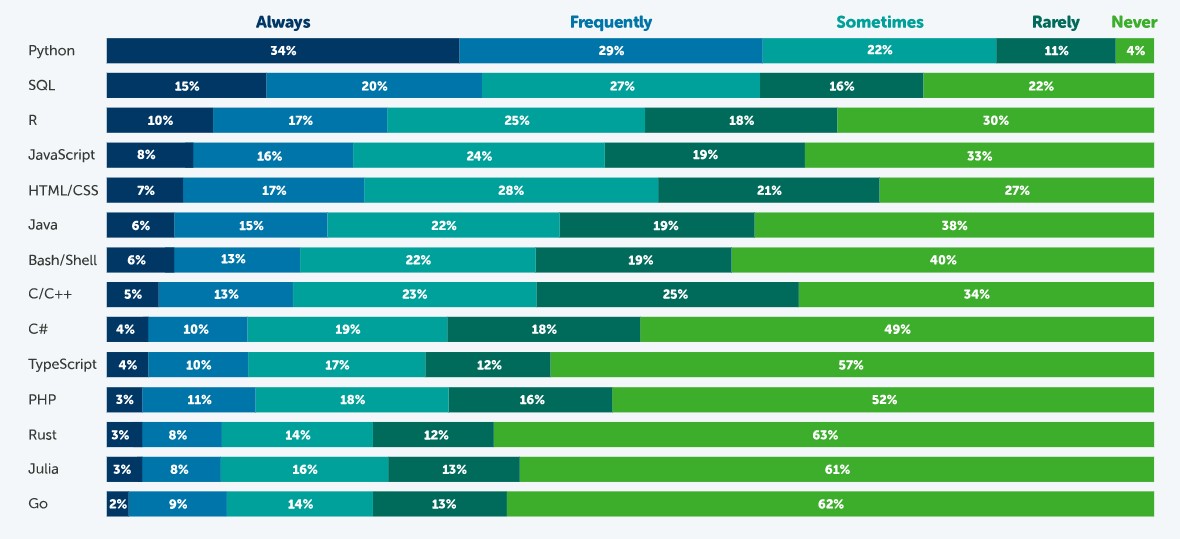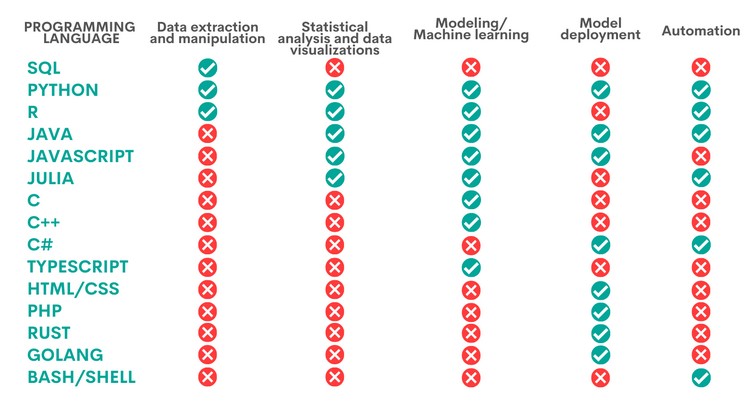
Python, R, SQL, JavaScript, C++, HTML... Nowadays we can find a multitude of programming languages that allow us to develop software programmes, applications, web pages, etc. Each one has unique characteristics that differentiate it from the rest and make it more appropriate for certain tasks. But how do we know when and where to use each language? In this article we give you some clues.
Types of programming languages
Programming languages are syntactic and semantic rules that allow us to execute a series of instructions. Depending on their level of complexity, we can speak of different levels:
- Low-level languages: they use basic instructions that are directly interpreted by the machine and are difficult for humans to understand. They are custom-designed for each hardware and cannot be migrated, but they are very efficient, as they make the most of the characteristics of each machine.
- High-level languages: they use clear instructions using natural language, which is more understandable by humans. These languages emulate our way of thinking and reasoning, but must then be translated into machine language through translators/interpreters or compilers. They can be migrated and are not hardware-dependent.
Medium-level languages are sometimes also described as languages that, although they function like a low-level language, allow some abstract machine-independent handling.
The most widely used programming languages
In this article we are going to focus on the most used high-level languages in data science. To do so, we look at this survey, conducted by Anaconda in 2021, and the article by KD Nuggets.
How often are the following programming languages used?

Source: State of Data Science in 2021, Anaconda.
According to this survey, the most popular language is Python. 63% of respondents - 3,104 data scientists, researchers, students and data professionals from around the world - indicated that they use Python always or frequently and only 4% indicated that they never use it. This is because it is a very versatile language, which can be used in the various tasks that exist throughout a data science project.
A data science project has different phases and tasks. Some languages can be used to perform different tasks, but with unequal performance. The following table, compiled by KD Nuggets, shows which language is most recommended for some of the most popular tasks:

Source: Data Science Programming Languages and When To Use Them, KD Nuggets, 2022.
As we can see, Python is the only language that is appropriate for all the areas analysed by KD Nuggets, although there are other options that are also very interesting, depending on the task to be carried out, as we will see below:
- Languages for data extraction and manipulation. These tasks are aimed at obtaining the data and debugging them in order to achieve a homogeneous structure, without incomplete data, free of errors and in the right format. For this purpose, it is recommended to perform an Exploratory Data Analysis. SQL is the programming language that excels the most with respect to data extraction, especially when working with relational databases. It is fast at retrieving data and has a standardised syntax, which makes it relatively simple. However, it is more limited when it comes to data manipulation. A task in which Python and R, two programs that have a large number of libraries for these tasks, give better results.
- Statistical analysis and data visualisation. This involves processing data to find patterns that are then converted into knowledge. There are different types of analysis depending on their purpose: to learn more about our environment, to make predictions or to obtain recommendations. The best language for this is R, an interpreted language that also has a programming environment, R-Studio, and a set of very flexible and versatile tools for statistical computing. Python, Java and Julia are other tools that perform well in this task, for which JavaScript can also be used. The above languages allow, in addition to performing analyses, the creation of graphical visualisations that facilitate the understanding of the information.
- Modelling/machine learning (ML). If we want to work with machine learning and build algorithms, Python, Java, Java/JavaScript, Julia and TypeScript are the best options. All of them simplify the task of writing code, although it is necessary to have extensive knowledge to be able to work with the different machine learning techniques. More experienced users can work with C/C++, a very machine-readable programming language, but with a lot of code, which can be difficult to learn. In contrast, R can be a good choice for less experienced users, although it is slower and not well suited for complex neural networks.
- Model deployment. Once a model has been created, it is necessary to deploy it, taking into account all the necessary requirements for its entry into production in a real environment. For this purpose, the most suitable languages are Python, Java, JavaScript and C#, followed by PHP, Rust, GoLang and, if we are working with basic applications, HTML/CSS.
- Automation. While not all parts of a data scientist's job can be automated, there are some tedious and repetitive tasks whose automation speeds up performance. Python, for example, has a large number of libraries for automating machine learning tasks. If we are working with mobile applications, then Java is our best option. Other options are C# (especially useful for automating model building), Bash/Shell (for data extraction and manipulation) and R (for statistical analysis and visualisations).
Ultimately, the programming language we use will depend entirely on the task at hand and our capabilities. Not all data science professionals need to know all languages, but should choose the one that is most appropriate for their daily work.
Some additional resources to learn more about these languages
At datos.gob.es we have prepared some guides and resources that may be useful for you to learn some of these languages:
- Data processing and visualization tools
- Courses to learn more about R
- Courses to learn more about Python
- Online courses to learn more about data visualization
- R and Python Communities for Developer
Content prepared by the datos.gob.es team.